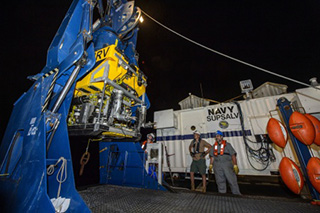A three-week search of the El Faro wreckage failed to spot the lost vessel’s voyage data recorder, and the National Transportation Safety Board said Monday it had ended the remotely operated vehicle search of the debris field, nearly three miles down.
“Over the years we’ve completed many investigations without the aid of recorders and other investigative tools,” NTSB Chairman Christopher A. Hart said in a statement issued by the agency. “While it is disappointing that the voyage data recorder was not located, we are hopeful that we’ll be able to determine the probable cause of this tragedy and the factors that may have contributed to it.”
The 790’x95’ TOTE Maritime ro/ro containership with its crew of 33 was last heard from on the morning of Oct. 1, immobilized after a main power plant failure and with flooding and a blown scuttle hatch reported. NTSB investigators were hoping to locate the voyage data recorder (VDR) to learn what happened when the ship’s automatic distress signals transmitted, as hurricane Joaquin beset the ship with 140-knot winds.
The 226’x42’x15’, 7,200 hp Navy fleet tug Apache, carrying side scan sonar, began searching an area around the last reported position, near Crooked Island in the Bahamas, and found the wreck Oct. 31 in 15,000’ of water. The ship was confirmed as the El Faro the next day, with use of the CURV-21 remotely operated vehicle with its video.
That imagery showed the navigation bridge and the deck below had separated from the rest of the ship’s house, including the mast and its base where the voyage data recorder was mounted, according to NTSB officials. With continued searching, the bridge was spotted Nov. 11, but the mast and VDR were not to be found nearby. The CURV-21 operators persisted with their search for another five days, but it is apparent the recorder cannot be located, the NTSB said.
“No further search missions are planned,” and that decision marks conclusion of the video documentation phase of the investigation, according to the NTSB statement.




